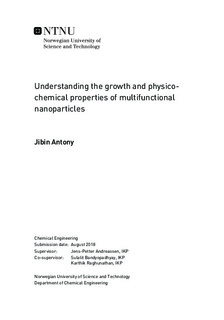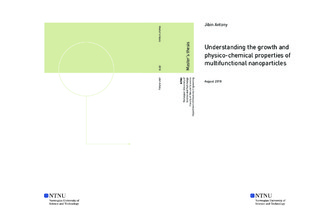| dc.description.abstract | Gold nanoparticles (Au NPs) exhibit localized surface plasmon resonance (LSPR) that provides wide applications in photothermal therapy, imaging and other theranostic applications. Recently, understanding the growth of anisotropic Au nanostructures has become an important topic of interest, since by controlling their growth, it is possible to optimize their physico-chemical properties. On the other hand, another class of nanomaterials that has garnered interest for stimuli directed release of cargo molecules are nanogels (NGs). Although NGs were initially studied for their temperature responsive behavior, it is possible to incorporate other sensitivities like pH, light, magnetism and so on to make them multifunctional.
In this project, polymerization methods developed in Ugelstad Laboratory were used to synthesize stimuli-responsive NGs and NGs coupled with inorganic NPs that can be triggered to release a cargo of interest in a controlled manner. Hybrid NPs (obtained by combining NGs with inorganic NPs) were synthesized via in situ polymerization by combining Au NSs with temperature and pH sensitive pNIPAm-AAc NGs. Primary focus of the study was on optimization of system parameters in order to modify the physico-chemical properties of the constructs. Three different molar ratios of the monomers were used to synthesize NGs/hybrid NPs having different physico-chemical properties. Increased size and stability of NGs/hybrid NPs could be observed at high AAc mole ratio.
The effect of size, concentration and surface charge of the NPs on the properties of resulting hybrid NP was studied. An optimum weight of 0.75 mg Au NS was chosen for the studies as it was shown to give prominent LSPR peak of Au, thereby enabling detection in addition to enhanced physico-chemical properties of the hybrid. The swelling-collapse properties of hybrid NPs in response to pH and temperature were compared to that of NGs at different molar ratios of AAc. Rapid swelling-deswelling characteristics were observed for NG/hybrid NP samples at high AAc mole ratio. Swelling effects were observed with an increase in pH for NG/hybrid NP samples maintained above their VPTT.
Time based studies were performed to obtain an understanding of the growth mechanisms involved in the synthesis of NGs/hybrid NPs. Loading studies were performed on these nanocarriers via breathing-in technique using Cyt C as model drug. Two different methods (dialysis and centrifuging) were studied to separate free Cyt C from the loaded systems. Since the maximum deviation observed in loading efficiencies (LEs) from these methods were only around ~13%, they were found to be comparable at all molar ratios of AAc. LEs were found to increase in NGs/hybrid NPs with an increase in AAc content, with values ranging from ~30% (AAc:10) to ~71% (AAc:25). The encapsulation efficiencies (EEs) were observed to range from ~180 µg/mg (AAc:10) to ~417 µg/mg (AAc:25).
Drug release profiles of bare NGs and hybrid NPs were studied at low pH (pH 3) and with an additional temperature stimulus (pH 3 + 40°C). Increased values of release exponents with additional temperature stimulus indicated a switch in geometry of the NG/hybrid NP matrix from spherical/cylindrical to thin film. This was also associated with a change in transport mechanism from anomalous transport to Case-II/Super Case-II transport. | |

